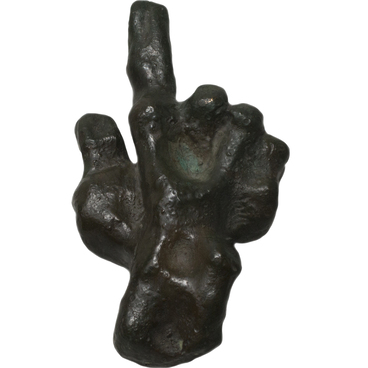Ernst Neizvestny, the author of the figurine for the All-Russian Television Competition, the amazing sculpture Tree of Life in Moscow and the Perm monument to Sergei Diaghilev, always treated human hands with special trepidation. In his sculptures, hands personify a man as a whole and are one of the central symbols in his creations.
The sculpture Hand is also symbolic. We see the hand of a man who squeezes the hand of a robot. This is the hand of the creator, the human creator, in which is the mechanized hand of his creation.
Judging by the recollections of the master himself, he often thought about the features of the human body and its capabilities. He wrote that in childhood he was afraid to imagine the end of the universe, after which there should have been a void. Infinity in his fantasies was dark and empty, frightening and terrifying.
To get rid of this image, the little boy began to imagine the Universe in the form of a nested doll: a small body is placed in a larger one, and a larger one in an even larger one and so on. He felt like he was the center of the universe, because all bodies are similar. By doing so the teenager freed himself from fear, he was no longer afraid of emptiness, because he felt like he was ‘part of a huge, enormous “I”.
These thoughts from the master’s diaries are very similar to psychoanalysis, but, in fact, his work has nothing to do with psychoanalysis. The Sculptor is not interested in complexes or even internal organs, his images glorify the integrity of human nature. The author’s goal is similar to those set by antique sculptors and Renaissance artists. But, unlike the masters of that time, who considered the human body to be the height of perfection, Ernst Neizvestny sees it adaptable, mutating.
Ernst Neizvestny’s position is not as unusual as it seems at first glance. For example, it is shared by 19th century romantic poets. In sculpture, Neizvestny reflected it first.
In addition to the museum in the homeland of the sculptor, in Yekaterinburg, there is another museum dedicated to his work - in the Swedish city of Uttersberg. Ernst Neizvestny Museum of Art in Sweden was created by the gallery owner Astley Nülen, was called the ‘Tree of Life’ and contains about a hundred diverse works of the master.
The most famous of the sculptor’s work is considered to be a bronze statuette of Orpheus. The original - a two-meter statue symbolizing the tragedy of the creator, Ernest Iosifovich created in 1962 after a fateful meeting with Nikita Khrushchev. Decades later, a small copy of the sculpture became a television award.
The sculpture Hand is also symbolic. We see the hand of a man who squeezes the hand of a robot. This is the hand of the creator, the human creator, in which is the mechanized hand of his creation.
Judging by the recollections of the master himself, he often thought about the features of the human body and its capabilities. He wrote that in childhood he was afraid to imagine the end of the universe, after which there should have been a void. Infinity in his fantasies was dark and empty, frightening and terrifying.
To get rid of this image, the little boy began to imagine the Universe in the form of a nested doll: a small body is placed in a larger one, and a larger one in an even larger one and so on. He felt like he was the center of the universe, because all bodies are similar. By doing so the teenager freed himself from fear, he was no longer afraid of emptiness, because he felt like he was ‘part of a huge, enormous “I”.
These thoughts from the master’s diaries are very similar to psychoanalysis, but, in fact, his work has nothing to do with psychoanalysis. The Sculptor is not interested in complexes or even internal organs, his images glorify the integrity of human nature. The author’s goal is similar to those set by antique sculptors and Renaissance artists. But, unlike the masters of that time, who considered the human body to be the height of perfection, Ernst Neizvestny sees it adaptable, mutating.
Ernst Neizvestny’s position is not as unusual as it seems at first glance. For example, it is shared by 19th century romantic poets. In sculpture, Neizvestny reflected it first.
In addition to the museum in the homeland of the sculptor, in Yekaterinburg, there is another museum dedicated to his work - in the Swedish city of Uttersberg. Ernst Neizvestny Museum of Art in Sweden was created by the gallery owner Astley Nülen, was called the ‘Tree of Life’ and contains about a hundred diverse works of the master.
The most famous of the sculptor’s work is considered to be a bronze statuette of Orpheus. The original - a two-meter statue symbolizing the tragedy of the creator, Ernest Iosifovich created in 1962 after a fateful meeting with Nikita Khrushchev. Decades later, a small copy of the sculpture became a television award.



